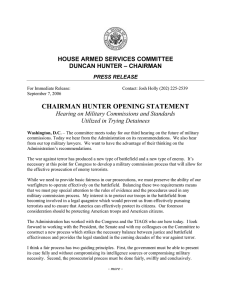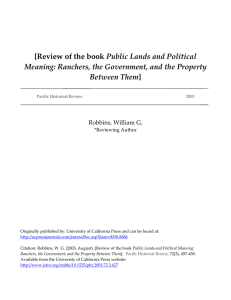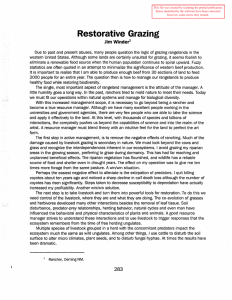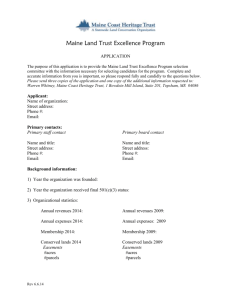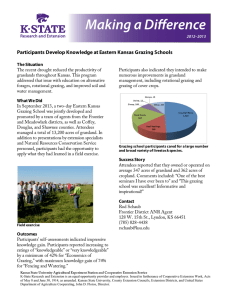Big Hole Land Exchange Socio-Economic Study 1. Introduction
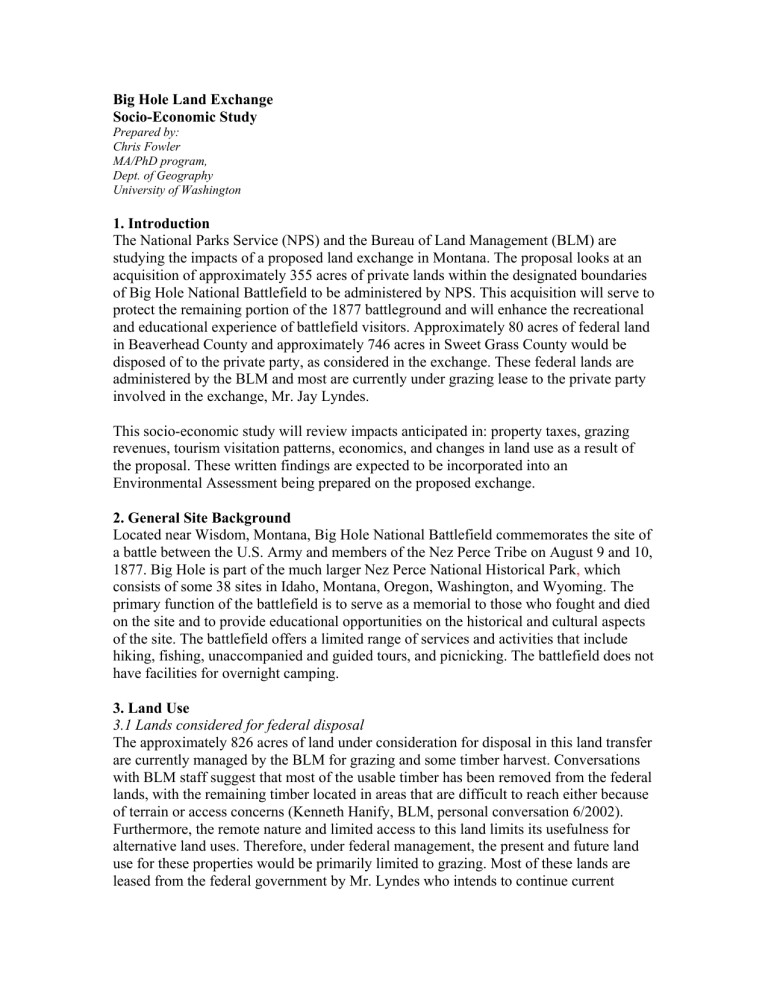
Big Hole Land Exchange
Socio-Economic Study
Prepared by:
Chris Fowler
MA/PhD program,
Dept. of Geography
University of Washington
1. Introduction
The National Parks Service (NPS) and the Bureau of Land Management (BLM) are studying the impacts of a proposed land exchange in Montana. The proposal looks at an acquisition of approximately 355 acres of private lands within the designated boundaries of Big Hole National Battlefield to be administered by NPS. This acquisition will serve to protect the remaining portion of the 1877 battleground and will enhance the recreational and educational experience of battlefield visitors. Approximately 80 acres of federal land in Beaverhead County and approximately 746 acres in Sweet Grass County would be disposed of to the private party, as considered in the exchange. These federal lands are administered by the BLM and most are currently under grazing lease to the private party involved in the exchange, Mr. Jay Lyndes.
This socio-economic study will review impacts anticipated in: property taxes, grazing revenues, tourism visitation patterns, economics, and changes in land use as a result of the proposal. These written findings are expected to be incorporated into an
Environmental Assessment being prepared on the proposed exchange.
2. General Site Background
Located near Wisdom, Montana, Big Hole National Battlefield commemorates the site of a battle between the U.S. Army and members of the Nez Perce Tribe on August 9 and 10,
1877. Big Hole is part of the much larger Nez Perce National Historical Park , which consists of some 38 sites in Idaho, Montana, Oregon, Washington, and Wyoming. The primary function of the battlefield is to serve as a memorial to those who fought and died on the site and to provide educational opportunities on the historical and cultural aspects of the site. The battlefield offers a limited range of services and activities that include hiking, fishing, unaccompanied and guided tours, and picnicking. The battlefield does not have facilities for overnight camping.
3. Land Use
3.1 Lands considered for federal disposal
The approximately 826 acres of land under consideration for disposal in this land transfer are currently managed by the BLM for grazing and some timber harvest. Conversations with BLM staff suggest that most of the usable timber has been removed from the federal lands, with the remaining timber located in areas that are difficult to reach either because of terrain or access concerns (Kenneth Hanify, BLM, personal conversation 6/2002).
Furthermore, the remote nature and limited access to this land limits its usefulness for alternative land uses. Therefore, under federal management, the present and future land use for these properties would be primarily limited to grazing. Most of these lands are leased from the federal government by Mr. Lyndes who intends to continue current
grazing practices on these lands for the foreseeable future (Jay Lyndes, personal conversation 6/2002). Therefore, there is no projected change in the land use for any of the federal lands considered for disposal.
3.2 Lands considered for federal acquisition
The 355 acres proposed for federal acquisition in this land swap are currently used for grazing by the property owner, Mr. Lyndes. The land is unimproved except for several irrigation ditches which also service the surrounding lands and are to remain in place through an easement after the proposed federal acquisition process.
After the proposed federal acquisition, these lands would be added to the national battlefield lands managed by the National Park Service.
Grazing on the land would cease as would any opportunity for commercial development. Conversations with NPS staff suggest that there is very little planned for the site other than an archaeological survey and the eventual addition of several hiking trails to facilitate interpretation of this integral part of the actual 1877 battlefield (Jon James, NPS, personal conversation 6/2002).
While the conversion from grazing to historic commemoration, interpretation, and passive recreation is a significant transition, the impact will likely be positive from an environmental standpoint; beyond future archaeological/cultural surveys to achieve a better understanding of the site’s history, much of the land will likely experience extremely low-impact use consistent with the NPS’s 1916 Organic Act mandate “…to conserve the scenery and the natural and historic objects and the wild life therein and to provide for the enjoyment of the same in such manner and by such means as will leave them unimpaired for the enjoyment of future generations.” There is therefore no projected negative impact resulting from the changes in land use associated with this project.
4. Grazing
4.1 Grazing on property considered for federal disposal.
The 826 acres under consideration for federal disposal are managed by the BLM for grazing. The leases on these lands pay into the federal treasury based on an estimate of
Animal Use Months (AUM’s) at a current rate of $1.43 per AUM. As a result, the conversion of these properties from Federal to private ownership will result in a loss in
Federal revenues. BLM staff in Sweet Grass County report that the 746 acres are currently leased for a total of 153 AUM’s (operator numbers 05466,05502,05503;
Kenneth Hanify, BLM, personal conversation, 6/2002), with an additional 8-10 AUM’s available on un-leased sections. This equates to $218.79 annually, with the potential for an additional $11- $14 per annum under full lease-out conditions. The 80 acres located in
Beaverhead County are permitted for 32 AUM’s, but the lessee has only been billed for
18 AUM’s over the past 10 years. The income from these leases would generate $25.74 under current conditions, or as much as $45.76 if all of the permitted AUM’s were utilized by the lessee. Taken together, these properties generate $244.53 per annum under current conditions, with the potential for generating as much as $278.85 per annum if the permitted AUM’s were fully utilized. These revenues would be lost to the federal government as a result of the proposed land exchange. The continued grazing of these lands under proposed private ownership will continue to contribute economic benefits to
the local economy as well as contributing to local tax rolls as described in section 5.1 below.
4.2 Grazing on property considered for Federal acquisition
The 355 acres under consideration for Federal acquisition are currently used for grazing by the property owner. After Federal acquisition, the property would not be used for grazing. This portion of the transfer involves no net change in Federal grazing revenues.
It is not expected that this reduction in the available lands for grazing would have any appreciable effect on grazing in the region as a whole.
5. Taxation
5.1 Taxation of lands considered for Federal disposal
The 826 acres under consideration for Federal disposal have not yet been appraised, and so calculations of future taxes can only be roughly estimated. Specifically, within the categories for grazing lands, property can be assessed at anywhere from $10.36 per acre to $647.40 per acre (personal conversation with Dept. of Revenue staff 6/02). In the absence of this information, the analyst requested taxation levels for lands adjacent to those proposed for Federal disposal. While there is certainly substantial room for error in these estimates, they represent the best information available at this time. Based on these estimates, the 80 acres within Beaverhead County would represent an increase in tax revenues of $70.34. The remaining 746 acres are located in Sweet Grass County and represent an increase in tax revenues of $313.32 to $674.72.
For the purposes of this study, the maximum value will be assumed.
5.2 Taxation of lands considered for Federal acquisition
Taxes on the lands under consideration for Federal acquisition amounted to approximately $312 in 2001.
If acquired by the Federal government, these lands would be subject to Payments in Lieu of Taxes (PILT) for the subsequent five years. Current federal guidelines for assessing the PILT levels for this property indicate payments based on 1% of the fair market value, but not to exceed the assessed property taxes for the year in which the property was acquired. The parcels under consideration have been assessed at a value of $23,954.61 (personal conversation with Dept. of Revenue staff 6/02) equating to annual PILT payments of $239.55 for each of the subsequent five years.
However, this payment is subject to a number of modifications based on Congressional funding of the PILT program, county funding ceilings, etc. As a result, $239.55 should be considered a maximum value in this case.
1
This range represents a difference in the method of calculation. At the low end, the per acre rate was generated by subtracting buildings, machinery, and livestock assessments from the total tax burden. This is believed to represent a level close to the actual tax burden that would be incurred by the owner after federal disposal of the lands. The upper end represents the total tax load divided by acreage without removing the assessments for improvements. This rate is equivalent to the rate calculated for Beaverhead county
2 properties for which detailed information was not available.
Based on conversation with Beaverhead County Dept. of Revenue and Dept. of Treasury staff 6/2002.
The properties under consideration fall within the tax ID for the Maverick Cattle Company with holdings of
890.57 acres and assessed taxes of $783.06. Assuming the taxes are allocated to the land proportionally,
$312.14 would be the amount attributable to the 355 acres under consideration.
6. Visitor Use and Tourism Economics
The Big Hole National Battlefield is an important tourist location within Beaverhead
County. The site receives approximately 60,000 visitors per year (NPS Public Use
Statistics Office Data 1991-2000) with highs of as many as 65,000 visitors. During the summer typical visitors spend approximately 2.5 hours at the site, while winter visitors average approximately 4hrs. The park is a day-use only facility, and it is believed that most visitors stop at the battlefield for a single day before moving on to other sites; however no data on the length of visitor stays in the region was available from the NPS or other sources to confirm this assumption. Activities at the battlefield are largely limited to education/interpretation of the site, hiking and exploring the battleground area.
Tourism does play an important role in Beaverhead County as a whole. In 1998 an estimated 490,000 visitor groups passed through Beaverhead County. Of these, and estimated 193,000 attended some historical or interpretive site. A 1999 study prepared by researchers at the Institute for Tourism and Recreation Research (ITRR) suggests that tourist dollars amounted to approximately $18.6 million in 1998. Although very few of these tourists listed historic sites or Indian culture as the primary reason for their visit to
Beaverhead County, the 60,000 visitors a year at the site do attest to a relatively high interest in the site among tourists visiting the area for any number of reasons.
Currently, the federal lands considered for disposal in this land exchange do not provide a significant recreational benefit, in part due to their scattered nature and limited public access. Consolidation of federal holdings adjacent to the battleground should increase visibility and access to public lands in this area.
The addition of 355 acres to the battlefield is not expected to have any immediate appreciable impact on visitation rates at the battleground unless the planned archaeological surveys uncover important new artifacts. Rather, the 355 acres will serve to consolidate the complete battlefield area under federal ownership. By consolidating federal holdings in the area, this acquisition will also present a more ecologically and aesthetically sound unit which can only improve the battlefield’s recreational, educational, and commemorative values.
Assessing the economic benefits, attributable to the battlefield, that accrue to the region is problematic. The estimation of these benefits requires information on how many visitors come to Beaverhead County specifically to visit the site and how long visitors to
Beaverhead County extend their stay in the region because of their interest in the site.
Specifically, for benefits to be attributed to the battlefield it must be demonstrated that a portion of the tourist dollars (the benefit) would not have been spent in the region if the battlefield had not been there. For example, money spent by a family visiting relatives in the area that goes out to dinner in Wisdom after spending the afternoon at the Battlefield could not be said to provide a battlefield-related benefit; it is likely that they would have come to Wisdom and eaten out even if the battlefield had not been there. Alternatively, a family driving through Beaverhead that stops at the battlefield and subsequently decides to spend the night in Wisdom rather than continuing on to Glacier that day could be considered a battlefield-dependent benefit. This is complex and extremely site specific
information, the collection of which was not warranted in the preparation of this report.
Furthermore, the benefit accruing as a result of the proposed federal acquisition would be limited to only the increases in benefiting visitation or changes in visitation behavior (e.g. longer stays in the region). Since few if any changes in visitation or visitation behavior have been attributed to the proposed federal acquisition, the economic benefits associated with these changes are expected to be limited.
7. Summary
In summary, the proposed land exchange would result in a net loss of $483.08 per year
from the federal treasury while providing approximately $745.06 in additional tax revenues for Beaverhead and Sweet Grass counties (less Federal and State revenues). The exchange would likely have no appreciable affect on land use or tourism in the area, though the consolidation of federal holdings adjacent to the battleground will help to ensure that the battlefield will continue to provide a desirable educational, recreational experience. The addition of the remaining portion of the 1877 battlefield will enhance the experience of many park visitors while protecting the artifacts and cultural resources located on the site.
8. Reference Materials/ Further Information
Ellard, J., et al. “Beaverhead County Explores Tourism Potential” for the Institute for
Tourism and Recreation Research, School of Forestry, University of Montana.
Research Report 60. 1999. available on the web at: http://www.forestry.umt.edu/ research/MFCES/programs/itrr/reports_tourdevel.htm. accessed 8/5/02
Money Generation Model. Spreadsheets and user information available on the web at: http://www.prr.msu.edu/mgm2/ accessed 8/5/02.
Historical and other information related to the Big Hole National Battlefield located on the web at: http://www.nps.gov/biho/ accessed 8/5/02.
3
For the first five years. The amount would be reduced to $244.53 thereafter.

